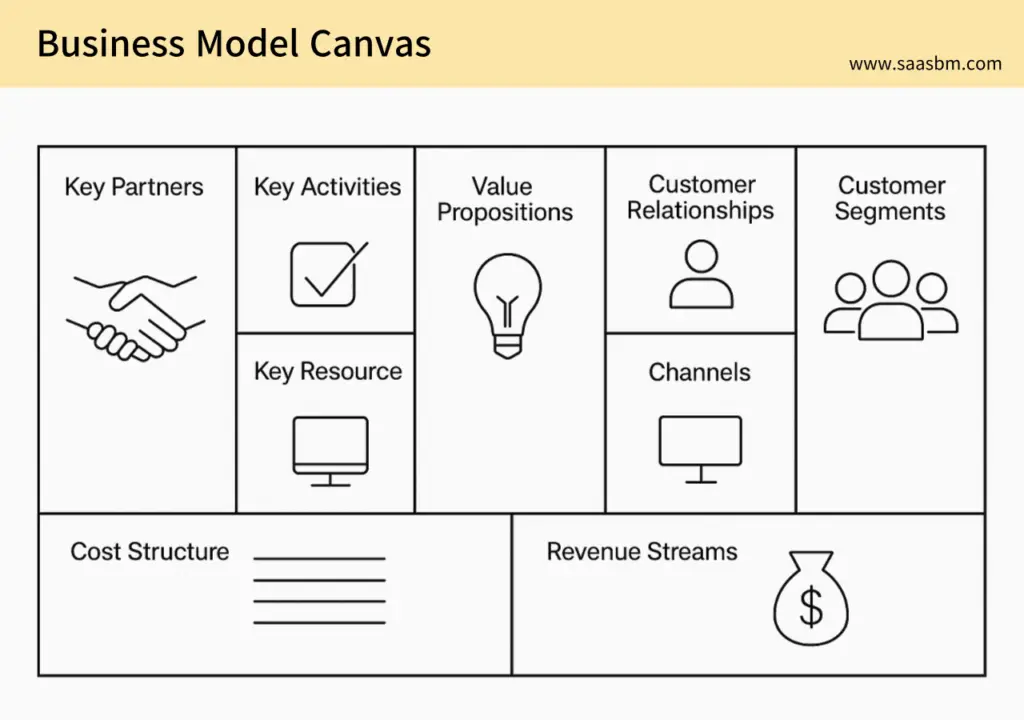Introduction
So you’ve got a great SaaS idea.
You’re planning to build something useful, maybe even revolutionary.
But here’s the catch:
Do you really understand how your business will work — from product to profit?
This is where the Business Model Canvas (BMC) becomes essential.
It helps SaaS founders and product teams visualize their entire business model on a single page. No 50-page business plans. No guesswork. Just clarity.
In this post, you’ll learn:
- What the Business Model Canvas is
- Why it’s a must-have for SaaS founders
- A breakdown of the 9 key elements
- A real-world SaaS example
- How to apply BMC to your own idea
Let’s dive in.
What Is the Business Model Canvas?
The Business Model Canvas (BMC) is a strategic framework created by Alexander Osterwalder.
It helps you describe how your product creates, delivers, and captures value — all in one visual map.
Rather than writing lengthy business plans, the BMC focuses on 9 building blocks that cover every core aspect of your business:
- Customer Segments
- Value Propositions
- Channels
- Customer Relationships
- Revenue Streams
- Key Resources
- Key Activities
- Key Partnerships
- Cost Structure
In short, the BMC answers this:
“Who are we building for, what are we offering them, and how will it all work operationally and financially?”
Why the BMC Matters for SaaS Startups
SaaS startups often move fast — launching features, acquiring users, iterating endlessly.
But without a structured model, speed can lead to chaos.
The BMC gives you clarity, alignment, and direction:
- ✅ Validate your business model early
- ✅ Map your product to real customer needs
- ✅ Communicate clearly with your team or investors
- ✅ Spot weak links before investing too much
For SaaS businesses where monthly recurring revenue, retention, and scalability are key, the BMC is not optional — it’s foundational.
The 9 Building Blocks of a SaaS Business Model
1. Customer Segments
Who are your ideal users?
Define your primary customers as clearly as possible.
Example: “Remote-first creative agencies with teams under 20 people”
2. Value Propositions
What problem are you solving?
What makes your solution valuable and different?
Example: “A distraction-free project management tool built for creative workflows”
3. Channels
How will customers find and use your product?
What are the key touchpoints?
Example: “Content marketing → free trial → in-app onboarding → paid plan”
4. Customer Relationships
What type of support or engagement will you offer?
Example: “Self-service for SMBs, account managers for enterprise customers”

5. Revenue Streams
How do you make money?
What pricing strategy are you using?
Example: “$12/month/user with optional paid integrations”
6. Key Resources
What are your essential assets — technical, human, or financial?
Example: “Full-stack dev team, cloud infrastructure, proprietary scheduling engine”
7. Key Activities
What are the most important things your business must do well?
Example: “Product development, onboarding optimization, content creation”
8. Key Partnerships
Who are your strategic collaborators or third-party providers?
Example: “Stripe for billing, Firebase for backend, Intercom for support”
9. Cost Structure
What are your biggest costs?
What does it take to run your SaaS?
Example: “Developer salaries, server costs, ad spend, customer support”
Real-World Example: FocusBoard – A Lightweight Team Collaboration SaaS
Let’s imagine a SaaS product called FocusBoard — a minimalist team collaboration tool for remote workers.
Here’s what its Business Model Canvas might look like:
- Customer Segments: Freelancers, remote creative teams, async-first startups
- Value Proposition: Simplified collaboration without distraction
- Channels: Blog, YouTube tutorials, LinkedIn ads
- Customer Relationships: In-app chat + help docs + Slack community
- Revenue Streams: Freemium model + $12/month/user
- Key Resources: Core development team, UI/UX designer, AWS
- Key Activities: Weekly product releases, bug fixes, user feedback loop
- Key Partnerships: Google SSO, Stripe, Notion API
- Cost Structure: Hosting fees, support, content marketing, dev salaries
Summary
| Traditional Approach | BMC Approach |
|---|---|
| Long business plans | Visual one-pager |
| Feature-first thinking | Customer and value-driven |
| Confused team communication | Aligned through shared canvas |
| Unclear monetization | Tested, structured revenue flows |
The BMC isn’t just a canvas — it’s a conversation starter, a clarity tool, and a strategy lens.
Final Thoughts
The Business Model Canvas isn’t about perfection — it’s about understanding.
For SaaS founders, it offers a fast, visual way to de-risk your idea and sharpen your value proposition.
It helps you answer questions like:
- Who are we really building this for?
- What pain are we solving?
- How will we acquire, retain, and monetize users?
Before writing your next line of code or pitching your next investor, ask yourself:
“Can I explain our entire business on one page?”
If not, start with the Business Model Canvas — because clarity is the foundation of traction.

No comment yet, add your voice below!